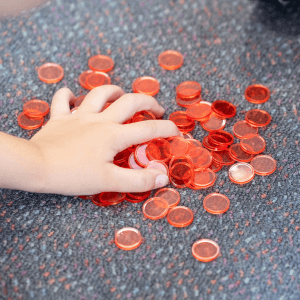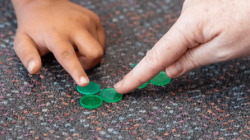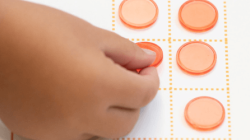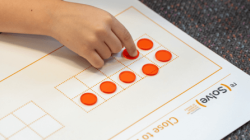'Number: Taking handfuls' is one of our new teaching sequences for V9
- On the 'In this sequence' tab you'll find all the tasks in this sequence, a suggested implementation plan and curriculum alignment.
- The 'Behind this sequence' tab shows how key mathematical ideas develop over the sequence.
- Have you taught this sequence? Use the Feedback button to let us know how it went!
Tasks in this sequence
Task 1 • How big is a handful?
Students learn that there are some ways of arranging items in a collection to make it easy to see the total number of items.
Task 2 • Rolling Handfuls
A short dice-rolling game builds students’ understanding that the same quantity can be arranged in different ways without changing the total.
Task 3 • Comparing handfuls
Students learn that common units are needed to easily compare and order different quantities.
Task 4 • Towers of 5
Students build their ability to use benchmark numbers to quantify and compare collections.
Task 5 • Using 10
Students learn the value of using 10 to quantify and compare larger collections.
Task 6 • Close to 20
Students build their use of 10 as a benchmark to quantify and compare collections.
Suggested implementation
This time plan is just one way that you might choose to implement this sequence. We have used a warm-up activity at the start of most lessons, and some tasks are split across two lessons. The timing provided in the tasks’ documentation align with this implementation advice.
| Week 1 | Week 2 | |
|---|---|---|
| Monday | Task 1 • How big is a handful?
| Task 5 • Using 10
|
| Tuesday | Task 2 • Rolling handfuls
| Task 5 • Using 10
|
| Wednesday | Task 3 • Comparing handfuls
| Task 6 • Close to 20
|
| Thursday | Task 3 • Comparing handfuls
| Task 1 • How big is a handful?
|
| Friday | Task 4 • Towers of 5
| Task 6 • Close to 20
|
Curriculum and syllabus alignment
Achievement standards
In Foundation, students make connections between number names, numerals and position in the sequence of numbers from zero to at least 20. They use subitising and counting strategies to quantify collections. Students compare the size of collections to at least 20. They partition and combine collections up to 10 in different ways, representing these with numbers. Students represent practical situations that involve quantifying, equal sharing, adding to and taking away from collections to at least 10.
Australian Curriculum V9 alignment
Number
Name, represent and order numbers including zero to at least 20, using physical and virtual materials and numerals
Recognise and name the number of objects within a collection up to 5 using subitising
Quantify and compare collections to at least 20 using counting and explain or demonstrate reasoning
Partition and combine collections up to 10 using part-part-whole relationships and subitising to recognise and name the parts
Sequence design overview
“Number sense can be described as a good intuition about numbers and their relationships. It develops gradually as a result of exploring numbers, visualising them in a variety of contexts, and relating them in ways that are not limited by traditional algorithms.” (Howden 1989, p.11)
We build a sense of numbers by exploring the relationships that exist between them. In Foundation, the numbers 1 to 20 are the focus. In this sequence, students explore relationships between numbers 1 to 20 through subitising, comparison, and using 5 and 10 as benchmarks.
The information presented in the video is summarised in the Sequence framework below.
Sequence framework
| Learning goals | Students’ mathematical activity | Representation | |
|---|---|---|---|
| Task 1 | Organising a collection helps to count accurately. Some ways of arranging collections make it easy to see how many there are without needing to count. | Students take a handful of objects (e.g. counters) and arrange them in a way that makes it easy to see how many there are. | Subitisable patterns |
| Task 2 Build | Quantity can be determined without counting by seeing small collections at a glance. The same quantity can be arranged in different ways without changing the total in the collection. | Pairs of students each take a handful of objects (e.g. counters) and each arrange them in a way that makes it easy to see how many there are. Students compare the different arrangements. | Subitisable patterns |
| Task 3 | Comparing allows us to order quantities and determine which quantity has more and which has less. A common unit allows us to quickly compare quantities. | Pairs of students each take a handful of objects and then arrange the two collections, so it is easy to quantify and also compare. | Subitisable patterns |
| Task 4 Build | 5 is a useful benchmark to quantify and compare smaller collections. | Students take a handful of cubes and describe the total number in their handful in relation to 5. | 5 cubes joined in a similar structure to a five-frame |
| Task 5 | 10 is a useful benchmark to quantify and compare larger collections. | Students take a handful of counters and describe the total number in their handful in relation to 10. | Ten-frame |
| Task 6 Build | 10 is a useful benchmark to quantify and compare larger collections. | Pairs of students each take a handful of counters, describe the total number in their handful in relation to 10, and then determine which collection is closest to 20. | Ten-frame |







